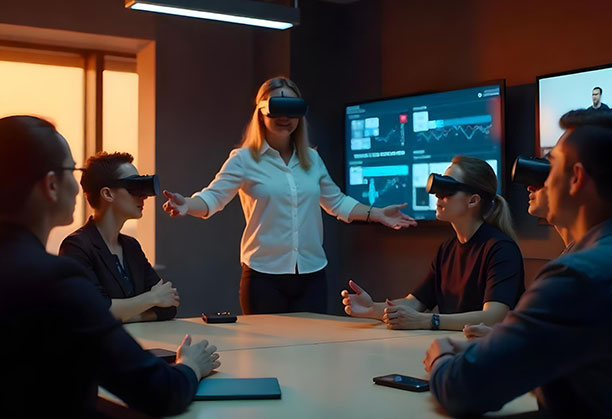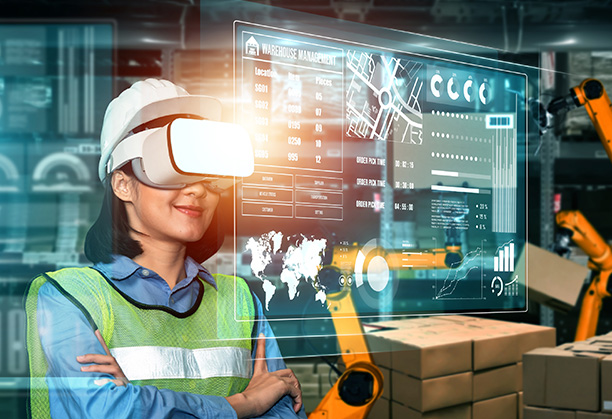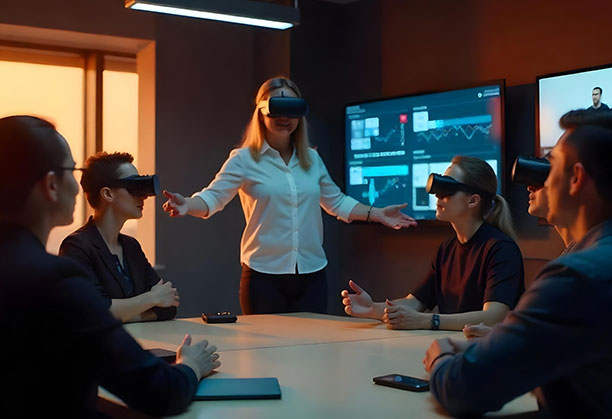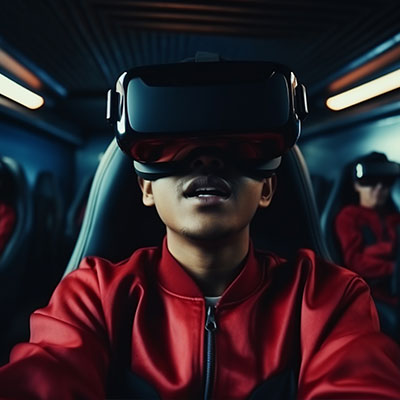VR training has moved beyond being just a cool technology. It’s now changing how companies train their teams across all industries. Workers learn faster, remember more, and perform better when using VR training.
Many companies start with small VR training tests. But the real challenge is growing these programs to work across your whole organization. This guide will show you how to scale VR training successfully without the headaches that often come with growth.
Why Scaling VR Training Matters
When workers train in VR, they learn 4 times faster than with traditional methods. They also feel over 2.5 times more confident in their new skills. These benefits make a big difference, especially in industries where safety and skill matter most.
The real impact comes when you expand access to immersive training programs across your company. When you scale up:
- Training costs go down as more people use the system
- Workers get the same high-quality training no matter where they are
- Skills improve across your whole organization
- New training can be rolled out quickly when needed
VR training that reaches your entire workforce gives your company a real advantage in today’s competitive market.
How to Scale VR Training: A Step-by-Step Approach
Step 1: Start With a Focused Pilot Program
Don’t try to scale everything at once. Begin with a targeted test in one area of your business. This helps you work out any problems before going bigger.
Choose a training need that would clearly benefit from VR, like:
- Safety procedures that are hard to practice in real life
- Complex equipment operation without risking expensive machinery
- Emergency responses that would be dangerous to rehearse
A hospital in Texas started with just one VR training module for emergency room procedures. After seeing completion rates jump by 89%, they expanded to five departments within six months.
Make sure to:
- Collect detailed feedback from both learners and trainers
- Track important numbers like completion rates and knowledge retention
- Use these results to build support for a bigger rollout
Step 2: Choose the Right VR Hardware
Your choice of VR equipment should match your training goals, budget, and work environment. Here’s a simple breakdown:
| VR Type | Best For | Benefits | Approximate Cost |
| Standalone Headsets | Training across multiple locations | Easy setup, no computer needed | $300-$500 |
| Tethered Systems | Complex training simulations | Higher quality graphics | $800-$1,500 + PC costs |
| Mobile VR Solutions | Basic awareness training | Very affordable and portable | $20-$100 + smartphone |
A manufacturing company we worked with chose standalone headsets for their factory floor training. This let workers train right in their work area without needing to set up computers.
Remember to plan for:
- Charging stations where headsets can be stored safely
- Regular cleaning between users (especially important in healthcare)
- Software updates and maintenance schedules
- Backup devices for when repairs are needed
Step 3: Create a Strong Training Environment
Your training space and technical setup are just as important as the headsets themselves. A good environment makes scaling much easier.
Design training areas with enough space for people to move safely. A manufacturing client converted unused meeting rooms into dedicated VR training spaces with clear floor markings to prevent accidents.
Your internet connection must be strong enough to handle multiple VR headsets at once. We recommend:
- Dedicated WiFi networks (5GHz works best)
- At least 100Mbps download speed for multiple users
- Cloud-based content delivery for easy updates across locations
One energy company installed special WiFi access points in their training areas, which solved the connection problems they had when first scaling up.
Step 4: Smart Content Management and Delivery

As you create more VR training programs, you’ll need a good system to manage them all. This becomes even more important when scaling to multiple locations or departments.
A good VR Content Management System (CMS) should:
- Store and organize all your training modules in one place
- Let you update content remotely across all locations
- Control who can access VR training programs
- Work with various types of VR headsets
Build your content in modules rather than as one big program. This approach lets you:
- Reuse parts across different training programs
- Update small sections without redoing everything
- Allow local teams to customize certain parts while keeping core content the same
A retail chain we worked with created a base customer service module, then let store managers add location-specific scenarios. This balanced consistent training with local needs.
Make your content available on tablets and smartphones too, not just VR headsets. This gives people more ways to learn, especially when headsets aren’t available or practical.
Step 5: Track Performance and Keep Improving
One of VR’s biggest advantages is the wealth of data it provides. Use this information to make your training better as you scale.
Modern VR platforms can track:
- Who completes which training modules
- How long people spend in different scenarios
- Where learners look and how they interact with objects
- Test scores and skill assessment results
- Technical performance like load times and system stability
An airline we partnered with discovered that maintenance trainees were spending too much time on one part of their VR training. They revised that section, reducing overall training time by 23%.
Create simple dashboards so managers can see how training is going across the organization. This helps them spot both problems and successes quickly.
As you gather more data, regularly update your training content based on:
- Common mistakes that learners make
- Feedback from workers and managers
- Changes in equipment or procedures
- New safety requirements

Step 6: Build Enthusiasm and Drive Adoption
Even the best VR training program won’t succeed if people don’t use it. Getting everyone on board is crucial for successful scaling.
Share success stories from your pilot program. A construction company posted short videos of workers sharing how VR training helped them work safer and more efficiently.
Find VR champions in each department who can:
- Help others get comfortable with the technology
- Answer basic questions and offer tips
- Show enthusiasm that spreads to their teammates
- Provide feedback to improve the program
Make the experience fun and engaging by adding:
- Points and badges for completing training
- Leaderboards that create friendly competition
- Real-world rewards for training achievements
- Scenarios where decisions have clear consequences
Hold regular demo days where employees can try VR training in a no-pressure environment. This helps reduce fear of new technology and builds interest.
Real Results from Scaled VR Training
When done right, scaled VR training delivers impressive results:
A manufacturing company reduced safety incidents by 43% after rolling out VR safety training to all factory workers.
A healthcare system trained 3,000 nurses on new equipment in just two weeks—a process that would have taken months using traditional methods.
An oil and gas company saved over $2 million in travel costs by delivering the same training virtually to workers across 12 countries.
Ready to scale VR Training Solution?
Partner with Juego neXR for Seamless VR Training Solution
Juego neXR helps organizations implement VR training without building in-house teams. We create custom training for any industry with content that grows as you expand. Our platform manages deployment to any number of headsets while tracking performance data. We integrate with your current systems and provide the expertise to transform VR from a small pilot into a core part of your training strategy.
Conclusion
Scaling VR training needs more than just hardware—it requires aligning technology, content, and culture. Companies that do this gain advantages through faster learning, better retention, and higher engagement. Industry reports now call VR “the key to scalable training” for businesses. By following best practices in planning, content design, and change management, companies are changing how their teams learn and perform in complex environments.
Frequently Asked Questions (FAQs)
Start by reviewing what worked in your pilot—completion rates, learner feedback, and performance data. Then, build a rollout plan that includes standardizing hardware, preparing training spaces, setting up content delivery systems, and creating support materials for users.
Track both cost savings and learning outcomes. Look at reduced travel, faster training times, fewer accidents, and improved employee performance. Many companies also compare knowledge retention and error rates before and after using VR.
Yes. Most users adapt quickly with a short onboarding module that teaches basic controls. Also, having VR champions within each team helps new users feel more comfortable and supported.
VR is ideal for hands-on, high-risk, or complex tasks that are hard to practice in real life. Examples include safety drills, equipment handling, emergency response, soft skills, and customer service simulations.
Use a modular approach to content creation. This makes it easier to update individual sections without redoing the whole program. Also, set regular review cycles based on feedback and performance data.
Revolutionize the future of business with Juego neXR
Related Posts
Share this Article:
Our Offices

India
Bangalore
GR Grand Plaza, 2nd Floor, JP Nagar, 6th Phase, Bangalore – 560 078

KSA
Jeddah
St Idris Square, 4036 Helmi Koutbi, Al Zahra, Jeddah 23425, Saudi Arabia
Follow Us On:
© 2025 Juego neXR. All Rights Reserved.




